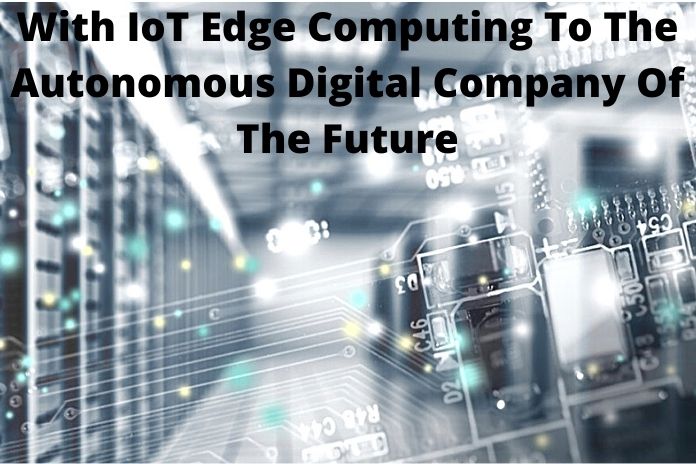For the next five years, businesses will continue to generate vast amounts of data from devices connected to the Internet of Things (IoT). While much of the attention has been focused on these devices, we are currently seeing a shift towards more interest in the data itself that these IoT devices are generating.
And more and more companies are becoming data-driven, too: They now realize that the most incredible opportunity to accelerate their business comes from the data generated, not the devices. As organizations turn to IoT to accelerate business initiatives, IT leaders must ensure that devices, architecture, automation, and human intelligence work in harmony to create a better employee and customer experience.
In this way, IT executives can increase operational efficiency, reduce the time spent on everyday administrative tasks, and strengthen network security to provide a better experience for the end-user. This is the framework for the autonomous digital enterprise, a concept that we will continue to see rollout in shops, schools, and cities in the years to come.
BMC predicts that technology will form the foundation of every business function by 2025, given the unprecedented growth in big data applications. The Internet of Things will be the foundation for this reality, and companies that learn to use IoT effectively will survive the disruption unscathed and gain a competitive advantage.
What Is IoT Edge Computing?
The core of an IoT solution is usually a central IT system for storing, processing, and analyzing IoT data. A large part of this IoT data can often be located in the cloud, i.e., outside the core system. This, in turn, can result in devices accessing the cloud for more extended periods, resulting in slower response times, less reliable operation, and sometimes incredible frustration for employees and customers. Companies can meet these challenges by using edge processing.
Edge computing services and IoT are inextricably linked. The edge computing services facilitate communication, and IoT, in turn, enables digital transactions. As a result, edge services act as a valuable autonomous digital resource that can dramatically improve a company’s ability to process, store, and analyze IoT device data. This helps companies manage and control these devices more effectively, protect them from vulnerabilities, and gain valuable insights from the data they generate.
Data Processing At The Edge Is Crucial
The term “Edge Computing” is probably just as misunderstood in the market as “IoT” because it has different meanings for different people, organizations, and industries.
It usually refers to an element of processing, recording, and triggering commands for monitoring, controlling, and optimizing certain functions at the original location with calculation at the sensor or device level and upwards through other on-site infrastructures (server cabinets, gateways, etc.).
It could be a smart meter on a power grid, a sensor on a remote oil rig, a CNC machine in an automobile factory, or even the PLC that controls it and other appliances on an assembly line.
The Autonomous Digital Company And IoT Edge Computing
The independent digital company will operate on a seamless IoT Edge AI-based computing solution that enables IT administrators, to:
- Configure what data to store locally and set a data aging policy.
- Define conditions with adjustable time windows to identify patterns in the incoming IoT data as the basis for automated events. For example, certain conditions can initiate transactions and notify the appropriate parties.
- Execute business transactions at the Edge to ensure the continuity of critical business functions, even when the Edge and core are separate.
- Use predictive models to analyze the IoT data that is constantly being trained. The predictive algorithm is trained in the core system and then applied at the Edge.
- Apply deep learning algorithms specially designed for image and video analysis at the Edge.
- Examine the data collected at the Edge. For example, after an alarm has been sent to the core system, an analyst can investigate the details that led to the notice.
These functions help companies to converge, analyze and prioritize operational and IT data seamlessly. As such, they can serve two critical roles: (1) better predicting and fixing potential problems before they disrupt customers, and (2) the ability to extract more valuable and actionable insights from data.
These two components are critical to a superior employee experience that binds and attracts talent and a transcendent customer experience that creates long-term loyalty and ultimately drives business forward.
Conclusion
Looking to the future, we are ready to deploy additional devices across the company to support business needs, such as occupancy sensors, instruments for tracking plant parameters, devices for monitoring industrial plants, and other solutions to ensure productivity and efficient use of resources. IoT edge computing is playing an increasingly important role in companies as IoT technology is becoming more and more anchored in our daily lives.
In some companies, network needs and the use of these devices can become even more acute if they opt for long-term remote work or flexible home office concepts. With the increase in IoT devices and the volume of data they generate, edge computing is becoming increasingly important. Today’s emerging independent digital businesses realize that getting suitable devices is not enough.
As every business becomes a data-driven technology company by 2025, the actual market leaders will be those who leverage IoT strategically to effectively collect, analyze, and apply vast amounts of data faster and more intelligently than their competitors.
Also Read: Internet Of Things (IoT) – What It Is And How To Use It Safely

